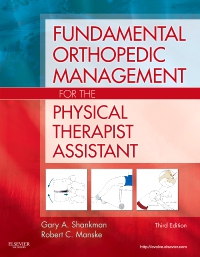
Fundamental Orthopedic Management for the Physical Therapist Assistant - Elsevier eBook on VitalSource, 3rd Edition
Elsevier eBook on VitalSource

Now $56.69
Designed to meet the unique needs of physical therapist assistants, Fundamental Orthopedic Management for the Physical Therapist Assistant, 3rd Edition focuses on critical thinking and helps you apply fundamental orthopedic principles in physical therapy interventions. Clear explanations cover basic concepts such as the PTA's role in physical assessment of flexibility, strength, endurance, and balance, along with the specifics of tissue healing; medications; gait and joint mobilization; and an introduction to biomechanics. It also describes the application of therapeutic interventions for many orthopedic conditions by region and affliction. Edited by two experienced clinicians, Gary A. Shankman and Robert C. Manske, and written by contributors who are experts in their respective fields, this is your one-stop source for PTA practice in orthopedics.
Newer Edition Available
Fundamental Orthopedic Management for the Physical Therapist Assistant - Elsevier eBook on VitalSource
-
- Clear explanations of difficult concepts are provided by experienced, practicing clinicians who address the specific needs of the PTA.
- Comprehensive coverage provides a "one-stop" source for all things orthopedic, from core concepts related to orthopedics to information about the PTA's role in physical assessment and interventions, in-depth reviews of types of tissue healing, biomechanics, and pharmacology.
- A focus on critical thinking and application helps to prepare you for the treatment room and for the clinical practicum portions of the curriculum.
- Key terms and learning objectives begin each chapter, useful as "checkpoints" to which you can refer to ensure content comprehension and study effectively for examinations.
- Over 500 illustrations reinforce concepts and procedures, supplemented by summary tables and boxes.
- End-of-chapter review questions prepare you for the types of critical thinking you will be required to do in practice.
- Unique! End-of-chapter glossaries define key terms.
- Appendices provide a quick reference for information such as laboratory values, common medications, and associated movements.
- A six-part structure organizes the book's material:
- Part I: Basic Concepts of Orthopedic Management begins with the essential concepts of teamwork and shared responsibility within the physical therapy team and then covers the basic areas of flexibility, strength, endurance, balance, and coordination.
- Part II: Review of Tissue Healing introduces the types of tissue, then discusses ligament, bone, cartilage, muscle and tendon healing before looking briefly at neurovascular healing and thromboembolic disease.
- Part III: Common Medications in Orthopedics focuses on common medications used in orthopedics, their actions, side effects, and possible impact on treatment.
- Part IV: Mobilization and Biomechanics deals with the basics of human movement including a chapter on gait, and provides information on joint mobilization.
- Part V: Management of Orthopedic Conditions by Region covers the body from the ankle, foot, and toes up to the shoulder, the elbow, and the wrist and hand, including a chapter on the spine.
- NEW! Part VI: Management of Orthopedic Conditions by Affliction includes chapters on hot topics such as rheumatic disease; pain and pain-related syndromes; and bracing, orthotics, and prosthetics.
- Student resources on a companion Evolve website include critical thinking applications, review questions, animations, reference lists from the book linked to MedLine, and more.
-
- More than 30 new contributors participated in this new edition, allowing you to learn from experts in each field.
- Unique! Rheumatic Disorders chapter covers disorders such as arthritis, gout, fibromyalgia, and systemic lupus erythematosus, including pathophysiology, a description of the inflammation, and pharmacological and non-pharmacological interventions.
- Unique! Pain and Pain Syndromes chapter covers types of pain, pain mechanisms, its measurement, and its management.
- Unique! Bracing, Orthotics, and Prosthetics chapter outlines the types of materials used to construct braces, orthotics, and prosthetics; the use of each unit by anatomic area; their biomechanics; the indications and contraindications for each; as well as an introduction to amputation.
-
Part I: Basic Concepts of Orthopedic Management
1. Patient Supervision and Observation During Treatment
2. The Role of the Physical Therapist Assistant in Physical Assessment
3. Flexibility
4. Strength
5. Endurance
6. Balance and Coordination
Part II: Review of Tissue Healing
7. Composition and Function of Connective Tissue
8. Ligament Healing
9. Bone Healing
10. Cartilage Healing
11. Muscle and Tendon Healing
12. Neurovascular Healing and Thromboembolic Disease
Part III: Common Medications in Orthopedics
13. Concepts of Orthopedic Pharmacology
Part IV: Mobilization And Biomechanics
14. Fundamentals of Gait
15. Concepts of Joint Mobilization
16. Biomechanical Basis for Movement
Part V: Management of Orthopedic Conditions by Region
17. Orthopedic Management of the Ankle, Foot, and Toes
18. Orthopedic Management of the Knee
19. Orthopedic Management of the Hip and Pelvis
20. Orthopedic Management of the Lumbar, Thoracic, and Cervical Spine
21. Orthopedic Management of the Shoulder
22. Orthopedic Management of the Elbow
23. Orthopedic Management of the Wrist and Hand
Part VI: Management of Orthopedic Conditions by Affliction NEW!
24. Orthopedic Management of Rheumatic Disorders NEW!
25. Orthopedic Management of Pain and Pain Syndromes NEW!
26. Orthopedic Management of Bracing, Orthotics, and Prosthetics NEW!
Appendices
A: Commonly Used Medications in Orthopedics
B: Reference Ranges for Commonly Used Tests
C: Units of Measurement and Terminology for the Description of Exercise and Sport Performance
D: Fracture Eponyms
E: Major Movements of the Body and the Muscles Acting at the Joints Causing the Movement


 as described in our
as described in our 